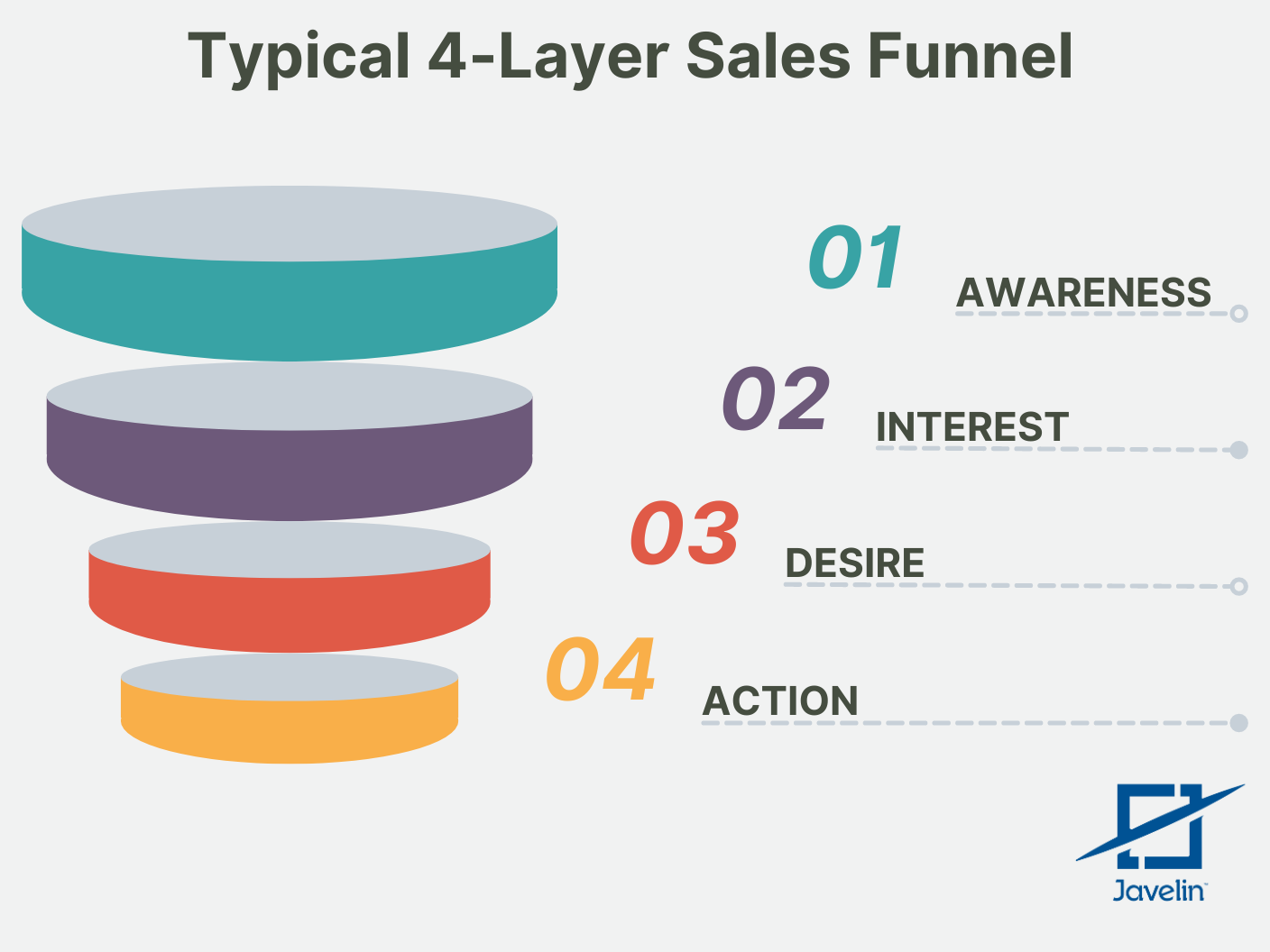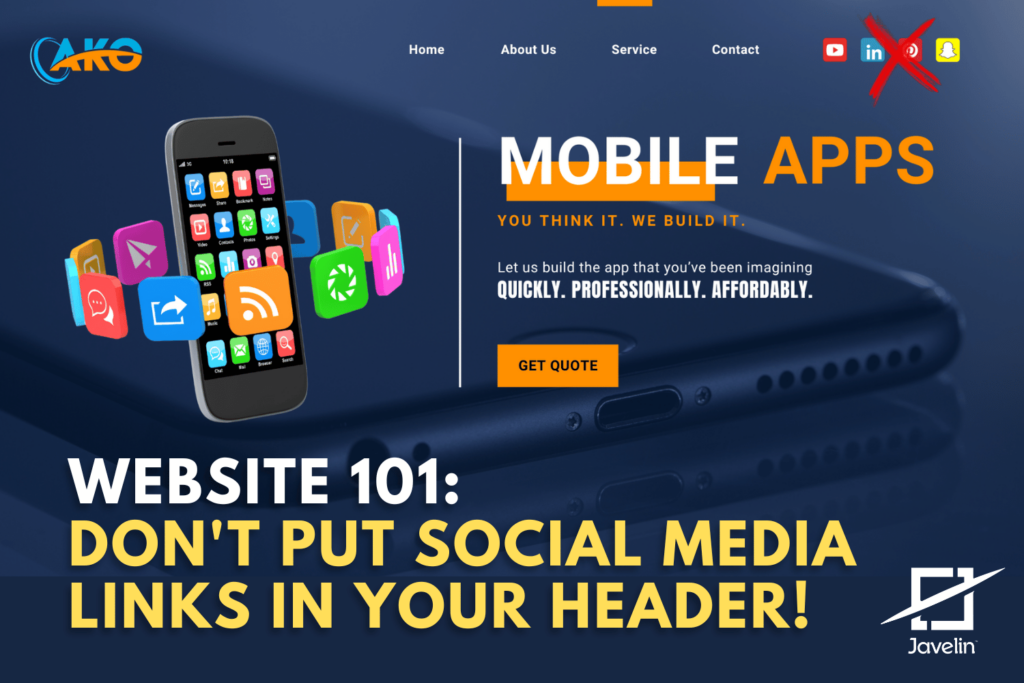You’d be surprised how often our clients ask to have social media links in the header of their website. There’s just something about those cute little icons that make even the most seasoned marketing folks swoon.
But here’s the thing; having your social media links on your website menu bar might is not as beneficial as you think. In fact, it’s probably doing more harm than good.
In this blog, we’ll explore why you should consider removing social media links from the menu bar in your header, in favor of a more practical method that can benefit your website’s performance and user experience.
And don’t worry, the ficticious company homepage example above was mocked up for this blog. No feelings were hurt in the creation of this blog!
Be Like Nike. Just Don’t Do It!

Don’t take my word for it. Google “Top 20 online shopping websites in the USA” and look for yourself. None of them do it, why should you?
In fact, I couldn’t find ANY national brand, from Amazon to Nike to Target to ZipRecruiter, that mentioned its social media channels anywhere but in the footer.
For instance, Target has strategically placed its social media links in the sub-footer (below), resulting in more intuitive and aesthetically pleasing menus.

Emulate the strategies of these national brands, who have invested significant resources and time in marketing and user behavior research.
Their decision to place social media links in the footer is not arbitrary; it’s based on extensive research and testing. They are industry leaders for a reason, and their success can be a guiding light for your website optimization.
And, speaking of Nike, their homepage has no social media links at all in either the menu bar OR footer (below). This shows that even the biggest brands are constantly reevaluating and experimenting with their website design to create the best possible user experience.

The Downsides of Social Media Links in the Menu Bar
Increased Bounce Rates
Social media links in the menu bar can be a double-edged sword. While they provide an easy exit for visitors, they also lead them away from your website. When users click these links, they are redirected to social platforms filled with distractions, diverting their attention from your site.
This can lead to increased bounce rates, a metric that search engines interpret as a sign that your site isn’t meeting the needs of visitors. High bounce rates can significantly impact your SEO, making it harder for potential customers to find your site in search results.
Disrupted User Journey
The primary purpose of the menu bar is to guide visitors through your website’s key areas, such as services, products, and contact information. Social media links in the menu bar can disrupt this navigation flow, leading users away from essential content and reducing the likelihood of conversions.
Your Website Is Not at The Top of Your Sales Funnel
Think about it: You’ve worked hard to drive traffic to your website through your social media strategy—why would you want to send them right back?
Consider this: your website is the destination where you capture leads and make conversions leading to a sale, a quote request, or an appointment booking. A ‘sales funnel ‘, is a marketing concept that describes the journey a potential customer takes from first becoming aware of your brand to making a purchase.

Social media appears toward the top of the funnel and casts a wide net promoting Awareness, Interest/Consideration, and Desire/Brand Preference, ultimately delivering interested buyers to your website (unless, of course, you sell directly from your social accounts) – the Action stage.
Having social media links in the menu bar encourages users to leave before taking any action, disrupting this journey and potentially leading to lost conversions. It’s crucial to keep this in mind when optimizing your website.
A More Effective Alternative
I get it; you’re proud of the effort you’ve put into your social media accounts. But if those efforts result in website traffic, they’ve done their job.
Encourage Engagement with Relevant Content
Instead of redirecting users back to your social media platforms, create engaging and relevant content that keeps them on your website.
This could include blog posts that provide in-depth information about your products or services, videos that demonstrate how to use your products, or interactive elements such as quizzes or polls that encourage social media interaction and sharing.
Improve User Experience
Removing social media links from the menu bar can also improve your website’s overall user experience. It reduces distractions and allows visitors to focus on the primary purpose of their visit—learning about your products or services. This can lead to more extended site visits and a higher chance of conversions.
The Benefits of Moving Social Media Links to the Footer
Improved User Experience
Placing social media links in the footer keeps the menu bar clean and focused on essential navigation elements. This helps visitors quickly find the information they seek without unnecessary distractions, leading to a smoother and more enjoyable browsing experience.
Enhanced Website Performance
Social media widgets and links can slow down your website’s loading times, especially if placed in the menu bar, which is loaded on every page. By moving these links to the footer, you can minimize their impact on page speed, resulting in faster load times and improved performance.
Better Focus on Conversions
With social media links relegated to the footer, your menu bar can highlight critical areas that drive conversions, such as product pages, contact forms, and service descriptions. These are the essential navigation elements that should take priority in your menu bar, as they are the key areas where visitors can take action that benefits your business.
How to Effectively Integrate Social Media Links in the Footer
Keep It Subtle
Incorporate small, recognizable social media icons in the footer without overwhelming the design. Ensure they are easily accessible but not intrusive, balancing visibility and subtlety.
Utilize simple, clean icons for your social media links that align with your website’s overall design. Avoid overly complex or flashy designs that detract from the site’s aesthetic and user experience. Opt for simple white or black social icons – save the color icons for email campaigns – but you should still keep them in the footer!
Optimize for Mobile
Make sure your footer, including social media links, is optimized for mobile devices. Responsive design ensures that the footer remains user-friendly across all screen sizes, providing a seamless experience for mobile users.
Nothing Is Universal
Before making any changes to your website’s menu bar, consider your target audience and industry. While the majority of businesses may benefit from moving social media links to the footer, a few may find success with them in the menu bar.
The key is to conduct A/B testing to determine what works best for your goals and audience. Remember, nothing is universal, and you have the power to find the best strategy for your website.
The Social Share Option

If you really want those cute social icons on your website, consider “social share” links instead, which allow your readers to share blogs or landing pages on their social channels.
These links can be incorporated into the content itself or placed in a separate sharing bar or dropdown menu (shown above) that appears when users hover over an image. You’ve likely seen these in news posts and influencers’ blogs.
The Last Word
While it may seem counterintuitive, removing social media links from your menu bar can positively impact your website’s performance and user experience. By incorporating them into the footer instead, you can still showcase your social media presence while keeping visitors focused on your website’s primary goals.
This change could lead to increased engagement, longer site visits, and ultimately, more conversions. So, next time you’re tempted to add those cute little icons to your menu bar, consider giving them a new home in the footer instead. Your website (and potential customers) will thank you for it!
So next time you’re tempted to add those cute little icons to your menu bar, consider giving them a new home in the footer instead. Your website (and potential customers) will thank you for it!
As with any marketing strategy, it’s important to evaluate and adjust it regularly based on data and user behavior. Consider testing different placements for social media links and monitoring their impact on your website’s performance.
Remember, the ultimate goal is to create a seamless and engaging user experience that drives conversions and builds brand loyalty. Don’t be afraid to experiment and find what works best for your specific target audience. Happy designing!
Need Help Optimizing Your Website?
Our team at Javelin offers website design and optimization services to help you create a user-friendly and conversion-driven online presence. Contact us today to learn more and elevate your brand’s digital presence!
Incorporating social media links into the footer is just one aspect of optimizing your website for conversions. It’s essential to regularly evaluate and improve all aspects of your site, from design to content, to ensure it effectively meets the needs of your target audience.
By continuously striving for excellence in user experience, you can drive conversions and build a loyal customer base that will propel your business toward success.
FAQs
Q: Why shouldn’t social media links be in the menu bar?
A: Social media links in the menu bar can lead users away from your site, increasing bounce rates and disrupting the user journey. Placing them in the footer reduces these risks while still maintaining accessibility.
Q: How can moving social media links to the footer improve my website’s performance?
A: Moving social media links to the footer can enhance website performance by reducing the load on the menu bar, leading to faster page load times and a better user experience.
Q: Will visitors still find my social media links if they are in the footer?
A: Yes, visitors interested in finding your social media profiles will look for them in the footer, a typical and expected location for such links.
Q: Can I still drive social media engagement without menu bar links?
A: Absolutely. You can promote your social media profiles through blog posts, email newsletters, and other digital marketing channels, encouraging users to follow and engage with you on social media.
Q: Are there any exceptions to placing social media links in the footer?
A: If your business heavily relies on social media for customer interaction and support, consider placing social media links in a prominent yet non-intrusive part of your website, such as a sidebar or a dedicated social media section.
Javelin – Your Digital Content Strategy Partner
Does your wbsite need a facelift? Javelin can help! Contact us today and put Javelin’s expertise and experience to work for you!
